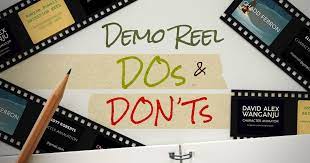We all love watching animated movies, don’t we? From Finding Nemo to Tangled to Frozen, we have watched all, laughed, and enjoyed it. But, have we ever thought about what goes into making such animated content?
As the world advances, the field of animation is gaining popularity with each passing year. As the search for new, interesting, and entertaining content rises, the demand for talented animators is also increasing. Be it animated movies, animated promotional videos, or a 3D character animation demo reel, every type requires a fine animator who understands and knows how to deal with such kind of work.
However, since this work is so much in demand, it makes the market competitive which causes difficulty for aspiring animators to bag the job of their dreams. Therefore, we bring some do’s and don’ts for our fellow animators to help them develop their character animation reel like a pro which shall get them hired. By knowing the steps to take (and to avoid) from the beginning, you’ll be able to set yourself a bright future!
So, without further adieu, let’s start!
The Do’s
Adjust Your Reel To The Job:
Rule Number 1 is to design your reel as per the job application. Many budding animators make the mistake of using the same reel for every job and end up failing. While you might believe it’s time-efficient, it might cost you your whole future. If your reel doesn’t fit the job position you’re applying for, the studio would probably undermine your talent by supposing you lack precision and attention to detail.
Hence, this step encourages developing your character reel based on the job description. For instance, if the position is specifically related to character animation, your reel should display the work you’ve done in that area, instead of the unrelated parts.
Think of it this way, just like how your resume should fit the job requirements, your reel should be tailored for every specific position. Also, make sure you know the relevant animation studios style when creating your reel.
Focus On Your Best Work:
Rule number 2 to keep in mind is to make sure your reel only consists of work that is polished and emphasizes the skills you need for the job you’re applying for. It’s natural to want to show everything that you have to offer, however, editing is the key to designing a professional reel.
Ideally, the duration of the reel should be a minute or two. This might mean trimming clips that you love, but do not serve the right purpose of the job thus they need to be removed.
This is the step where you showcase your real talent by making sure your reel reflects your best work instead of everything you’ve ever done. To make your work stand out you need to identify the strongest aspects of your video and include those in it.
You have only one aim: to impress the studio and make them acknowledge your art. And, the only way to achieve that is to be selective while editing your work. That way the studio will be willing to see your video rather than simply rejecting it.
The Don’ts
Lose Track:
One of the most common mistakes of newbies is that they get carried away with the presentation and lose track of the actual purpose of the reel. And, that brings us to our first ‘don’t’ to remember. The presentation of your character animation is important, but how the physical reel is presented isn’t something to spend too much time stressing about.
Many animators in an attempt to get innovative with how the reel is exhibited to the studio, forget the key message or purpose of the reel which messes up with the smooth flow of the reel. Hence, instead of focusing on irrelevant aspects, work on making the content as interesting as possible.
A studio will value the quality of the work rather than the way your reel is delivered. They are interested in seeing your work, skill, and talent and not how the reel is packaged. Apart from this, remember to avoid any elements that will reduce the chances of your character animation being appreciated such as loud music or bold motion graphics.
Lie About Your Work:
Stretching the truth or exaggerating when applying for a job is never a good idea. We all know animation projects are mostly teamwork which means your reel may be a combination of different skills from various animators. What’s important to remember here is not to exclude this from your demo reel. You need to accredit every animator who worked on your reel.
Be transparent about it and don’t try covering it up. Having said that, using animation produced by some other person is a deal-breaker. Stealing another animator’s work will never be appreciated nor will it go unnoticed. Therefore, be authentic as much as possible.
It’s normal to feel your reel isn’t good enough, but that is not an excuse to plagiarise. What you can do is take ideas or inspiration or enroll in courses offered by a 3D animation school. This can significantly strengthen your skills while ensuring you come out as a strong animator.
Conclusion
Developing your character animation reel is a tough row to hoe. For people who are enthusiastic and passionate about this field, we hope these tips prove to be fruitful for you. It’s a field that demands time, effort, dedication, and an exploration of your skillset. So, when it’s time to create your demo reel, make sure you’re 100% sure you want to step into this field as well as follow these tips for extra guidance. Apart from this, there are plenty of institutes that offer classes on 3D animation and polish your skills. So, dear animators, it’s your job to make the world acknowledge and appreciate your art. Good luck!



